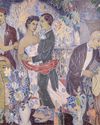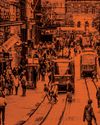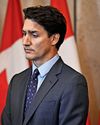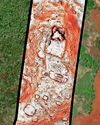
On the night of 13 March 1781, William Herschel was peering through his telescope in his back garden in New King Street, Bath, when he noticed an unusual faint object near the star Zeta Tauri. He observed it for several nights and noted that it was moving slowly against background stars. The astronomer first thought he had found a comet but later identified it, correctly, as a distant planet. Subsequently named Uranus, it was the first planet to be discovered since antiquity. The achievement earned Herschel membership of the Royal Society, a knighthood and enduring astronomical fame.
Studies have since shown Uranus to be an odd world. While the rest of the planets within our solar system spin like tops, Uranus lies on its side. And, although it is not the farthest planet from the sun, it is the solar system's coldest.
Uranus also endures seasons of extraordinary magnitude. Each pole spends decades bathed in non-stop sunlight, then decades of total darkness. For good measure, Uranus is the only planet to be named after a Greek rather than a Roman god. (Uranus was the grandfather of Zeus.)
Surprisingly little effort has been made to get up close to Uranus. Only one robot probe has visited - in 1986when the US Voyager 2 craft swept past on its grand tour of the solar system. It revealed a massive, featureless, pale blue world with an atmosphere of hydrogen, helium and methane, a rich family of moons and a powerful magnetic field. And that has been that.
Such slight regard is about to change. The US National Academy of Sciences this year published a report that urged Nasa to launch a Uranus probe as its highest-priority flagship mission for the next decade. The academy publishes a report on US priorities in planetary exploration every 10 years and each decadal survey carries enormous clout - which means Nasa is now under huge pressure to design and fund such a mission.
This story is from the {{IssueName}} edition of {{MagazineName}}.
Start your 7-day Magzter GOLD free trial to access thousands of curated premium stories, and 9,000+ magazines and newspapers.
Already a subscriber ? Sign In
This story is from the {{IssueName}} edition of {{MagazineName}}.
Start your 7-day Magzter GOLD free trial to access thousands of curated premium stories, and 9,000+ magazines and newspapers.
Already a subscriber? Sign In

Finn family murals
The optimism that runs through Finnish artist Tove Jansson's Moomin stories also appears in her public works, now on show in a Helsinki exhibition

I hoped Finland would be a progressive dream.I've had to think again Mike Watson
Oulu is five hours north from Helsinki by train and a good deal colder and darker each winter than the Finnish capital. From November to March its 220,000 residents are lucky to see daylight for a couple of hours a day and temperatures can reach the minus 30s. However, this is not the reason I sense a darkening of the Finnish dream that brought me here six years ago.

A surplus of billionaires is destabilising our democracies Zoe Williams
The concept of \"elite overproduction\" was developed by social scientist Peter Turchin around the turn of this century to describe something specific: too many rich people for not enough rich-person jobs.

'What will people think? I don't care any more'
At 90, Alan Bennett has written a sex-fuelled novella set in a home for the elderly. He talks about mourning Maggie Smith, turning down a knighthood and what he makes of the new UK prime minister

I see you
What happens when people with acute psychosis meet the voices in their heads? A new clinical trial reveals some surprising results

Rumbled How Ali ran rings around apartheid, 50 years ago
Fifty years ago, in a corner of white South Africa, Muhammad Ali already seemed a miracle-maker.

Trudeau faces 'iceberg revolt'as calls grow for PM to quit
Justin Trudeau, who promised “sunny ways” as he won an election on a wave of public fatigue with an incumbent Conservative government, is now facing his darkest and most uncertain political moment as he attempts to defy the odds to win a rare fourth term.

Lost Maya city revealed through laser mapping
After swapping machetes and binoculars for computer screens and laser mapping, a team of researchers have discovered a lost Maya city containing temple pyramids, enclosed plazas and a reservoir which had been hidden for centuries by the Mexican jungle.

'A civil war' Gangs step up assault on capital
Armed fighters advance into neighbourhoods at the heart of Port-au-Prince as authorities try to restore order

Reality bites in the Himalayan 'kingdom of happiness'
High emigration and youth unemployment levels belie the mountain nation's global reputation for cheeriness